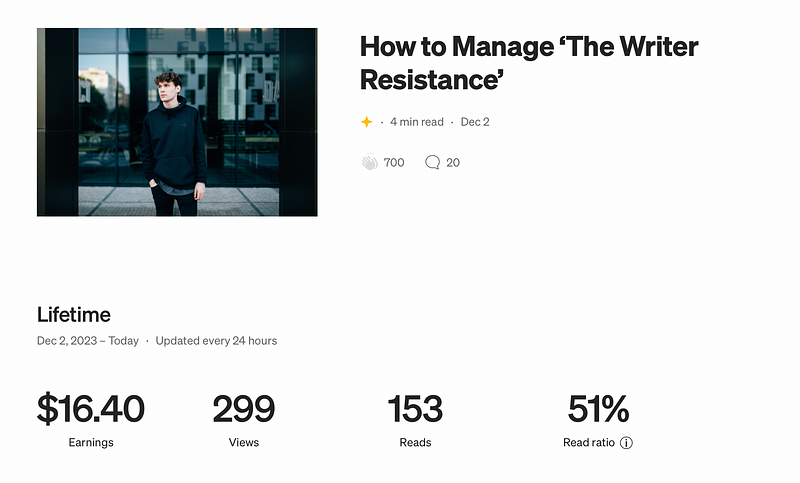How to Get Readers to Actually Read Your Writing
The subtle shift I learned the hard way

The online world is saturated with content. Written content is becoming a commodity because it’s so easy to replicate. Consequently, there is a flood of generic content on the internet.
The easy stuff, the threads you see time and time again become commonplace. The difficult stuff, the stuff that talks to storytelling, human connection, new ways to look at tricky stuff. That stuff becomes a rarity. It’s that stuff that stands out. It’s that stuff that you want to go after.
Today I want to talk to you about a subtle shift in your writing that will improve your chances of people reading your work, increase the chances of you getting yourself clients, and ultimately make you more money.
Here’s the shift and how you implement it in your writing.
Step 1: understand the difference between outputs and outcomes
People generally don’t become interested in the outputs until they understand the outcome. It’s only once they understand the outcome that they make sense of the output.
For example, take writing. If I said to you I’ve written 1,000+ articles on the internet you might think that’s cool (or crazy) but it’s an output. It means little until you understand the outcome of that — out-earning my full-time job has been one outcome.
- Output: the amount of something produced.
- Outcome: the consequence.
It’s the same at the gym, at home, at work. Outputs mean little until they are contextualized with the outcome. And most people are interested in the outcome first to justify the output.
AKA you need to hook people with the outcome and teach them about the output. If you want more people to listen to you, you need to start with your outcomes, and here’s how you do that.
Step 2: reframe your outputs and outcomes
A few weeks ago I wrote about my approach to building my audience with a 9 to 5 job. It’s been a journey to get to this point and I thought it might be useful for people to see how I’ve managed to juggle the two and be mildly successful on the internet.
I’ve written about this idea before in different ways but I’ve always talked about outputs instead of outcomes. For example, the article below talks about an output.
One way I’ve managed to stay writing on the internet for so long is that I’m able to manage my resistance to writing. It’s a mechanism I use to enable me to keep writing.
The mechanism is the output (the how) I keep writing. Building an audience of 88,000 is the outcome (the consequence).

This is below what I’m hoping to see in terms of results. Although the topic hits (20 comments) the not it’s not attracting enough people to read it. And that’s why I decided to shift to outcomes. Here’s how you do that.
Step 3: Headlines = outcomes
Instead of talking about outputs (what I do), I’ve shifted to talking about outcomes (the result). And it seems to be working if we take to recent articles:

You can see that both are framed as outcomes, not outputs. Both articles talk about the result, not the journey to get there.
My theory is this: People are hardwired to be skeptical. Before trusting you, they are asking themselves in their head ‘how do I know I can believe you?’, it’s why you need to start with the outcome.
It shows that you know what you’re talking about and that people should listen. The best way to get to your outcomes is to ask yourself ‘so what?’
Let’s say you’re writing an article about your experience as an HR consultant. You were in an interview the other day and a candidate was really surprised with the way they spoke about their past work experience.
- Starting point (what caught your interest): A candidate who spoke candidly about their work history and told stories left a lasting impression on you.
- Then ask yourself: so what? Well, as it turns out, this candidate wasn’t the most qualified but you found yourself much more taken with his story and he felt like a better fit to you.
- Think outcome: it turns out that telling honest stories about your work history gets you the job over someone more qualified.
Now the trick is to think about how you’d position this as a headline. Here’s what that might look like:
- Output headline: Why Tell Stories in Your Job Interview
- Outcome headline: How I Got the Job Without All The Qualifications
Which one would you rather read? In fact, the more I think about it the best approach is to speak to the outcome, without mentioning the output to maintain curiosity in your readers.
Step 4: Identifying your outcomes with the ‘Mum-Test’
You might be sitting there thinking, I’m not sure what things I can talk about, but there’ll be plenty of stuff for you to shout about you just need to know how to unearth them.
What would your mum be saying about you to her friends:
- He’s just landed that job at that big corporate firm.
- He’s graduated top of his class.
- He’s got 3 job offers.
They don’t have to be big things, they could be smaller things or just things that you think are pretty cool. As long as they are things you have done and you think they’re worth talking about you can shout about them.
P.S. If you liked this, you’ll probably love my best-selling course: The Medium Blueprint where I go in-depth about the secrets to writing on Medium. Join 460+ creators.
P.P.S If you want more content like this (designed to help folks with a 9 to 5 build on the internet) sign up for my free newsletter — The Part-Time Creator Club.
